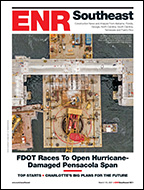
Engineers never planned to lift "Bertha"—at 57.5 ft in dia, the world's largest active tunnel-boring machine—out of its bored tunnel. But when it came time to remove for repair her 2,000-ton cutter-drive unit from 120 ft below downtown Seattle, heavy-lift specialist Mammoet created a custom gantry system for the job.
Due to the site constraints and soft waterfront soil conditions, Mammoet didn't have the typical foundation with which to work, forcing the Dutch-based firm to get creative with a fully hydraulic skid base that was 116 ft wide, 90 ft long and 105 ft tall—with a distance between the towers of 75 ft.
"I don't think that has ever been done before," says Jeroen Van Kooperen, Mammoet project manager. "To make the foundation work, we could have spent a lot of money in reinforcing." Instead, Mammoet created a hydraulic equalization system to "take away the torque that appears under every tower," he says.
Concrete piles at the site were built to stabilize the tunnel as it went through the soft waterfront area. "All of a sudden, we need to build a crane on top of that," Van Kooperen says. "We needed to support the crane to lift the load. The piles weren't designed for that."
Having built hydraulic bases before on non-gantry systems, Van Kooperen says engineers knew how hydraulics would react, but seeing the system work under a gantry "opens another way of thinking."
The 16-hour lift on March 30 took four weeks to prep, the amount of time afforded Mammoet, which used just machine drawings, as the piece was still underground. Having bid on the original lift of Bertha into the launch pit, Van Kooperen says he was familiar with the machine. To set up, the new project required 135 truckloads to enter downtown Seattle. The final layout saw Mammoet use steel beams to construct a modular tower to support the forces of the load. The hydraulic equalization under the tower, requiring 48 hydraulic cylinders, helped the system handle the uneven loads. The fluid in the system dispersed the weight of the load equally and in all directions to become self-balancing.
Project contractor Seattle Tunnel Partners (STP) is now fixing the TBM for the owner, Washington State Dept. of Transportation, before Mammoet picks and rotates the machine back into place. "It is basically the reverse of what we did," Van Kooperen says. With tight tolerances to fit the machine back in place, engineers expect more than 16 hours next time, but "it is just a matter of time," he adds.
Getting Bertha ready to bore again has been a focus of the $2-billion tunnel to replace Seattle's aging 63-year-old Alaskan Way Viaduct. The $80-million machine, built by Japan-based Hitachi Zosen, overheated in December 2013 and was shut down after traveling just over 1,000 ft—about 11%—into a 1.7-mile project. After months of uncertainty as to the reason for the overheating, STP determined the seals protecting the main bearing were compromised by dirt and debris.
STP decided not to enter the 325-ft-long machine from the rear through the tunnel's already bored portion, a tactic that would have required deconstructing Bertha to reach the $5-million main bearing and surrounding seals. Instead, the contractor dug a 120-ft-deep access pit in front of the TBM, allowing Mammoet to haul the front end to the surface for repairs.
WSDOT has contended all along that cost overruns—STP has not given an estimate to the costs incurred in this 17-month delay—remain the contractor's responsibility. The tunnel project connects to another mile of already completed new road in south Seattle, making Bertha's tunnel the centerpiece in a $3.15-billion overall project.
STP aims to have Bertha tunneling as soon as August. But first, Mammoet will need to place the cutterhead back on Bertha.



Post a comment to this article
Report Abusive Comment